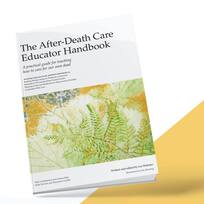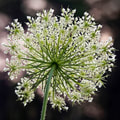Body Care Made EasyMoving the Body
Families may bring a body home after a death in a hospital or other institution, including from the Medical Examiner’s office, even before the death certificate (Preliminary Report of Death) has been signed. It is wise to check hospital or care facility body release policies well in advance if possible to ensure a smooth transition. Once the certificate has been signed, it functions as the Burial/Transit permit, which is required for transfer to the place of final disposition. (See How to Transport the Dead.) |
On This Page
|
Bathing, Dressing, and Casketing
Your loved one's body may be washed in bed or on a table with clear water, or with lavender or other essential oils added, or by using a cleaning product the person or family is used to using. Modesty can be preserved by covering your loved one with a sheet. Participants may choose to practice universal precautions if there is any concern. After the washing, dressing can be accomplished by cutting garments up the back and tucking them in underneath. Whether your loved one remains on a bed or table and later transferred to a casket, or is placed there after bathing, it may take four or five people to help move them.
Cooling
A body may be kept at home until the family is ready to cremate or bury. There is no time limit in Vermont law for a body to lie in honor; one to three days is common. Refrigeration is not necessary: a body will keep for that period without odors or significant changes in a 55 to 65 degree room if it has been properly cleaned and prepared under normal circumstances. Reduce the room’s temperature by opening the windows or with air conditioning if possible. Placing and periodically replacing dry ice or Techni-ice under and over the body will help cool the body. (Learn more about dry ice and Techni Ice™ in Cooling Techniques.)
Other than in rare, special circumstances, embalming is not required by law. For decades, it was utilized as a means of preserving deceased individuals between the time of death and disposition, but is not necessary with proper cooling.
Autopsy and Organ Donation
Neither autopsy nor organ donation are automatic disqualifications for bringing a body home for vigil. Many autopsied and harvested bodies have still been appropriate for a home vigil. Medical Examiners and other medical personnel, when informed prior to the procedure, will do their best to assist the family in repairing affected sites and incisions to make a body fit for viewing. Ask for a clear, detailed description of what procedures are being done and for advice on body care once the body is released. Knowing what you are about to experience will guide your decisions about what and how much to do, and how you will manage.
Your loved one's body may be washed in bed or on a table with clear water, or with lavender or other essential oils added, or by using a cleaning product the person or family is used to using. Modesty can be preserved by covering your loved one with a sheet. Participants may choose to practice universal precautions if there is any concern. After the washing, dressing can be accomplished by cutting garments up the back and tucking them in underneath. Whether your loved one remains on a bed or table and later transferred to a casket, or is placed there after bathing, it may take four or five people to help move them.
Cooling
A body may be kept at home until the family is ready to cremate or bury. There is no time limit in Vermont law for a body to lie in honor; one to three days is common. Refrigeration is not necessary: a body will keep for that period without odors or significant changes in a 55 to 65 degree room if it has been properly cleaned and prepared under normal circumstances. Reduce the room’s temperature by opening the windows or with air conditioning if possible. Placing and periodically replacing dry ice or Techni-ice under and over the body will help cool the body. (Learn more about dry ice and Techni Ice™ in Cooling Techniques.)
Other than in rare, special circumstances, embalming is not required by law. For decades, it was utilized as a means of preserving deceased individuals between the time of death and disposition, but is not necessary with proper cooling.
Autopsy and Organ Donation
Neither autopsy nor organ donation are automatic disqualifications for bringing a body home for vigil. Many autopsied and harvested bodies have still been appropriate for a home vigil. Medical Examiners and other medical personnel, when informed prior to the procedure, will do their best to assist the family in repairing affected sites and incisions to make a body fit for viewing. Ask for a clear, detailed description of what procedures are being done and for advice on body care once the body is released. Knowing what you are about to experience will guide your decisions about what and how much to do, and how you will manage.
Resources for Conducting Home Body Care
 Complete body care instructions included
Complete body care instructions included
Undertaken With Love: A Home Funeral Guide for Congregations and Families by Holly Stevens and Donna Belk is included in the newly republished After-Death Care Educator Handbook available through Amazon.
One Washcloth Project
One Washcloth facilitates healing by supporting individuals, communities, and institutions to engage family members in the care of a loved one directly after death through the simple gift of a washcloth.
NHFA Home Funeral Guidebook
The National Home Funeral Alliance Home Funeral Guidebook includes information and resources for caring for the dead with images and easy-to-follow instructions.
For more information leading to other How To pages, go to:
Complete Paperwork
Arrange Disposition
Transport the Dead
Create Ceremony
Go Out Greener
One Washcloth Project
One Washcloth facilitates healing by supporting individuals, communities, and institutions to engage family members in the care of a loved one directly after death through the simple gift of a washcloth.
NHFA Home Funeral Guidebook
The National Home Funeral Alliance Home Funeral Guidebook includes information and resources for caring for the dead with images and easy-to-follow instructions.
For more information leading to other How To pages, go to:
Complete Paperwork
Arrange Disposition
Transport the Dead
Create Ceremony
Go Out Greener
